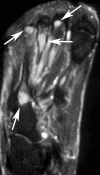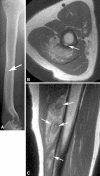Epithelioid hemangioma of bone and soft tissue: a reappraisal of a controversial entity
- PMID: 21948309
- PMCID: PMC3314752
- DOI: 10.1007/s11999-011-2070-0
Epithelioid hemangioma of bone and soft tissue: a reappraisal of a controversial entity
Abstract
Background: The controversy surrounding diagnosis of an epithelioid hemangioma (EH), particularly when arising in skeletal locations, stems not only from its overlapping features with other malignant vascular neoplasms, but also from its somewhat aggressive clinical characteristics, including multifocal presentation and occasional lymph node involvement. Specifically, the distinction from epithelioid hemangioendothelioma (EHE) has been controversial. The recurrent t(1;3)(p36;q25) chromosomal translocation, resulting in WWTR1-CAMTA1 fusion, recently identified in EHE of various anatomic sites, but not in EH or other epithelioid vascular neoplasms, suggests distinct pathogeneses.
Question/purposes: We investigated the clinicopathologic and radiologic characteristics of bone and soft tissue EHs in patients treated at our institution with available tissue for molecular testing.
Patients and methods: Seventeen patients were selected after confirming the pathologic diagnosis and fluorescence in situ hybridization analysis for the WWTR1 and/or CAMTA1 rearrangements. Four patients had multifocal presentation. Most patients with EH of bone were treated by intralesional curettage. None of the patients died of disease and only four patients had a local recurrence.
Results: Our results, using molecular testing to support the pathologic diagnosis of EH, reinforce prior data that EH is a benign lesion characterized by an indolent clinical course with an occasional multifocal presentation and rare metastatic potential to locoregional lymph nodes.
Conclusion: These findings highlight the importance of distinguishing EH from other malignant epithelioid vascular tumors as a result of differences in their management and clinical outcome.
Level of evidence: Level IV, prognostic study. See Guidelines for Authors for a complete description of levels of evidence.
Figures






References
-
- Antonescu CR, Zhang L, Chang NE, Pawel BR, Travis W, Katabi N, Edelman M, Rosenberg AE, Nielsen GP, Dal Cin P, Fletcher CD. EWSR1-POU5F1 fusion in soft tissue myoepithelial tumors: a molecular analysis of sixty-six cases, including soft tissue, bone, and visceral lesions, showing common involvement of the EWSR1 gene. Genes Chromosomes Cancer. 2010;49:1114–1124. doi: 10.1002/gcc.20819. - DOI - PMC - PubMed
-
- Deyrup AT, Montag AG. Epithelioid and epithelial neoplasms of bone. Arch Pathol Lab Med. 2007;131:205–216. - PubMed
Publication types
MeSH terms
Substances
Grants and funding
LinkOut - more resources
Full Text Sources
Medical
Research Materials

